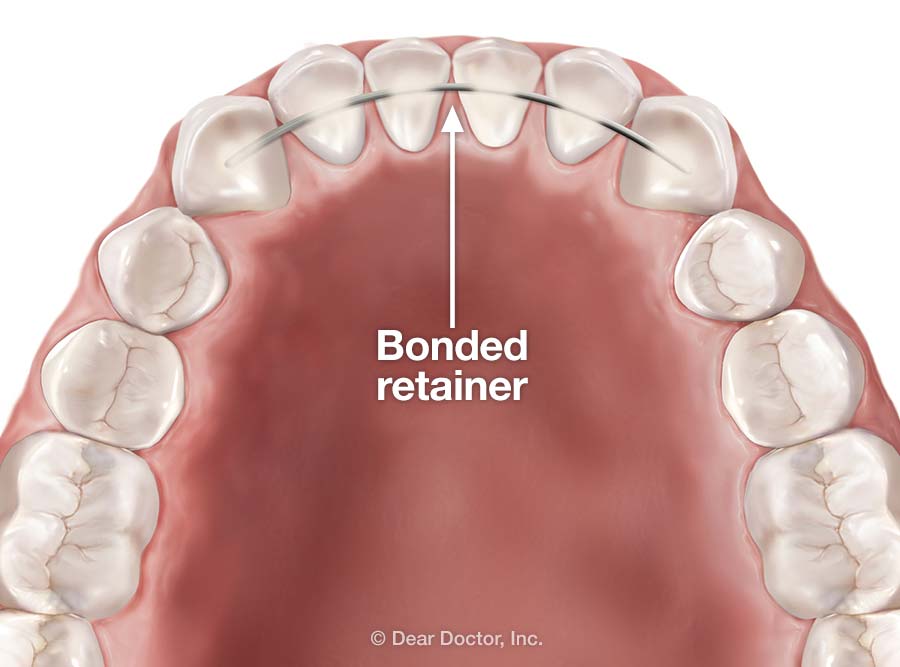Bonded Retainers
What are the pros and cons?
Dear Doctor,
My son is going to get his braces off soon, and his orthodontist told us his retainer will be bonded to his teeth. Aren't retainers supposed to be removable?
Dear Melissa,
I can understand your confusion: Given that your son's braces were bonded to his teeth, you may well be wondering how a non-removable retainer will be different. So first of all, I want to assure you that wearing a bonded (or "fixed") retainer is nothing like wearing braces.
A bonded retainer is a very thin piece of wire that is attached to the back of the teeth. It won't be visible when he smiles, though he will be able to feel it with his tongue — a sensation that takes a little getting used to. But once he does get accustomed to it, he will probably forget it's even there.
 |
| A bonded retainer is securely attached to the back (tongue) side of the front teeth. |
A non-removable retainer has some advantages and disadvantages compared to removable retainers. But before we discuss that, let's review why retainers are such an important part of orthodontic treatment.
Teeth on the Move
Although you wouldn't think so, teeth have the ability to move — in fact they move ever so slightly all the time, in response to the normal forces of biting and chewing. They are able to move because they are attached to the jawbone by a stretchy network of fibers called the periodontal ligament ("peri" – around; "odont" – tooth), and because bone is living tissue that reshapes itself in response to the forces that act upon it.
Orthodontists use braces to apply precise, controlled forces to the teeth in order to move them in a planned direction. These forces cause the periodontal ligament to stretch and the bone around the teeth to remodel. Bone cells are re-absorbed by the body on one side of the teeth in response to pressure; on the other side, new bone cells are added in response to the ligament being stretched.
But just as a rubber band that's stretched out can resume its original form when the tension is released, so too can the periodontal ligament (though not as quickly). Over time, if the ligament hasn't remodeled, it can attempt to go back to where it was; thus, the teeth attached to it will be pulled along with it — right back into a misaligned position.
The chance of this happening ("relapse potential") is particularly strong within the first three months after braces are removed, when the bony substructure around the tooth roots is relatively soft from the remodeling process. The risk gradually declines after this point, but never completely disappears. This is where retainers come in: Their purpose is to hold the teeth in the improved alignment created by orthodontic treatment.
Types of Retainers
The non-removable kind is bonded to the back of the teeth with a dental composite material that is hardened with a special curing light, and is very strong. Only a dentist can remove this type of retainer.
Although there are many different types of retainers, they can be divided into two basic categories: removable and non-removable. The non-removable kind is bonded to the back of the teeth with a dental composite material that is hardened with a special curing light, and is very strong. Only a dentist can remove this type of retainer. The process of bonding a retainer takes only a few minutes.
The advantage of a bonded retainer is that compliance is not an issue: There is no doubt your son will wear it because it can't be taken out. Also, as mentioned before, there is no cosmetic issue because it is hidden behind his teeth.
But there are also some disadvantages. Flossing, which is an essential component of effective daily oral hygiene, is much more difficult with a bonded retainer in place. And if your son decides to have the retainer removed years down the road, as many people do, or it breaks off of any or all of the teeth that it is bonded to, there is still a very real potential for the teeth to move out of alignment.
On the other hand, a removable retainer allows easy cleaning of the teeth. And it's not an all-or-nothing proposition: Your orthodontist may recommend wearing it 24/7 when the braces first come off, then only at night after the first year, and then occasionally in the years that follow. Of course, it's also possible that an individual may choose not to wear it at all — a decision no orthodontist would recommend, yet one we can't always influence.
Which, then, is the best type of retainer to use? That's a conversation you should have with your son's orthodontist. Sometimes a bonded retainer will be recommended in situations where there is a significant potential for the teeth to move back out of alignment: when a gap between the front teeth has been closed, for example.
I do have two suggestions for your son — or anyone who will be wearing a bonded retainer: First of all, make sure to get a demonstration from your dental hygienist on how to floss with the retainer in place. And, if you ever decide to have the bonded retainer removed, get a removable retainer made so that you will always have a way to maintain your beautiful, straight smile.




